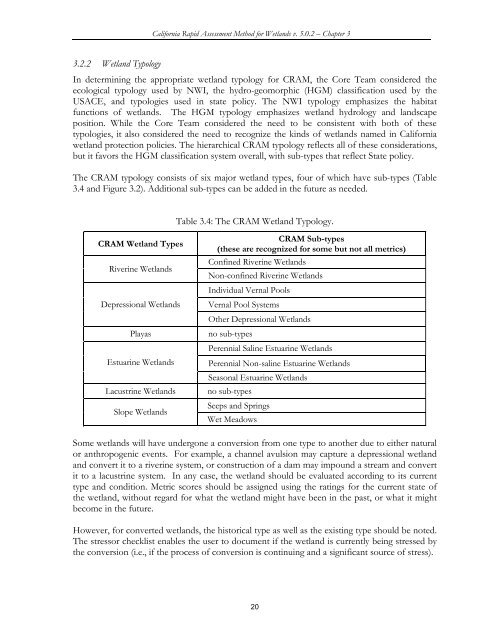(CRAM) For Wetlands User's Manual Version 5.0.2
(CRAM) For Wetlands User's Manual Version 5.0.2
(CRAM) For Wetlands User's Manual Version 5.0.2
You also want an ePaper? Increase the reach of your titles
YUMPU automatically turns print PDFs into web optimized ePapers that Google loves.
California Rapid Assessment Method for <strong>Wetlands</strong> v. <strong>5.0.2</strong> – Chapter 3<br />
3.2.2 Wetland Typology<br />
In determining the appropriate wetland typology for <strong>CRAM</strong>, the Core Team considered the<br />
ecological typology used by NWI, the hydro-geomorphic (HGM) classification used by the<br />
USACE, and typologies used in state policy. The NWI typology emphasizes the habitat<br />
functions of wetlands. The HGM typology emphasizes wetland hydrology and landscape<br />
position. While the Core Team considered the need to be consistent with both of these<br />
typologies, it also considered the need to recognize the kinds of wetlands named in California<br />
wetland protection policies. The hierarchical <strong>CRAM</strong> typology reflects all of these considerations,<br />
but it favors the HGM classification system overall, with sub-types that reflect State policy.<br />
The <strong>CRAM</strong> typology consists of six major wetland types, four of which have sub-types (Table<br />
3.4 and Figure 3.2). Additional sub-types can be added in the future as needed.<br />
Table 3.4: The <strong>CRAM</strong> Wetland Typology.<br />
<strong>CRAM</strong> Wetland Types<br />
<strong>CRAM</strong> Sub-types<br />
(these are recognized for some but not all metrics)<br />
Riverine <strong>Wetlands</strong><br />
Confined Riverine <strong>Wetlands</strong><br />
Non-confined Riverine <strong>Wetlands</strong><br />
Individual Vernal Pools<br />
Depressional <strong>Wetlands</strong> Vernal Pool Systems<br />
Other Depressional <strong>Wetlands</strong><br />
Playas no sub-types<br />
Perennial Saline Estuarine <strong>Wetlands</strong><br />
Estuarine <strong>Wetlands</strong> Perennial Non-saline Estuarine <strong>Wetlands</strong><br />
Seasonal Estuarine <strong>Wetlands</strong><br />
Lacustrine <strong>Wetlands</strong> no sub-types<br />
Slope <strong>Wetlands</strong><br />
Seeps and Springs<br />
Wet Meadows<br />
Some wetlands will have undergone a conversion from one type to another due to either natural<br />
or anthropogenic events. <strong>For</strong> example, a channel avulsion may capture a depressional wetland<br />
and convert it to a riverine system, or construction of a dam may impound a stream and convert<br />
it to a lacustrine system. In any case, the wetland should be evaluated according to its current<br />
type and condition. Metric scores should be assigned using the ratings for the current state of<br />
the wetland, without regard for what the wetland might have been in the past, or what it might<br />
become in the future.<br />
However, for converted wetlands, the historical type as well as the existing type should be noted.<br />
The stressor checklist enables the user to document if the wetland is currently being stressed by<br />
the conversion (i.e., if the process of conversion is continuing and a significant source of stress).<br />
20















